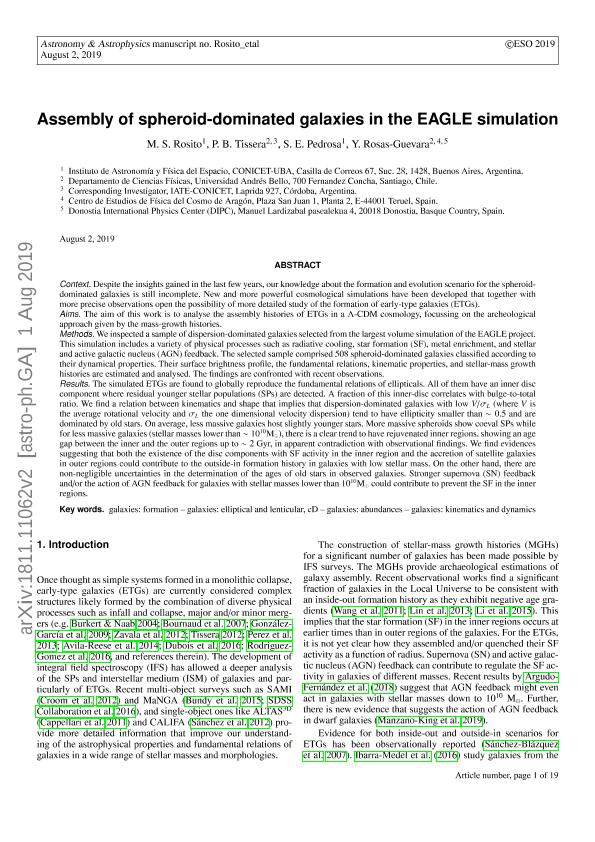Mostrar el registro sencillo del ítem
dc.contributor.author
Rosito, María Sol

dc.contributor.author
Tissera, P. B.
dc.contributor.author
Pedrosa, Susana Elizabeth

dc.contributor.author
Rosas Guevara, Y.
dc.date.available
2021-07-23T15:06:11Z
dc.date.issued
2019-08
dc.identifier.citation
Rosito, María Sol; Tissera, P. B.; Pedrosa, Susana Elizabeth; Rosas Guevara, Y.; Assembly of spheroid-dominated galaxies in the EAGLE simulation; EDP Sciences; Astronomy and Astrophysics; 8-2019; 1-19
dc.identifier.issn
0004-6361
dc.identifier.uri
http://hdl.handle.net/11336/136752
dc.description.abstract
Context. Despite the insights gained in the last few years, our knowledge about the formation and evolution scenario for the spheroid-dominated galaxies is still incomplete. New and more powerful cosmological simulations have been developed that together withmore precise observations open the possibility of more detailed study of the formation of early-type galaxies (ETGs).Aims. The aim of this work is to analyse the assembly histories of ETGs in a Λ-CDM cosmology, focussing on the archeologicalapproach given by the mass-growth histories.Methods. We inspected a sample of dispersion-dominated galaxies selected from the largest volume simulation of the EAGLE project.This simulation includes a variety of physical processes such as radiative cooling, star formation (SF), metal enrichment, and stellarand active galactic nucleus (AGN) feedback. The selected sample comprised 508 spheroid-dominated galaxies classified according totheir dynamical properties. Their surface brightness profile, the fundamental relations, kinematic properties, and stellar-mass growthhistories are estimated and analysed. The findings are confronted with recent observations.Results. The simulated ETGs are found to globally reproduce the fundamental relations of ellipticals. All of them have an innerdisc component where residual younger stellar populations (SPs) are detected. A correlation between the inner-disc fraction and thebulge-to-total ratio is reported. We find a relation between kinematics and shape that implies that dispersion-dominated galaxies withlow V/σ L (where V is the average rotational velocity and σ L the one dimensional velocity dispersion) tend to have ellipticity smallerthan ∼ 0.5 and are dominated by old stars. On average, less massive galaxies host slightly younger stars. More massive spheroidsshow coeval SPs while for less massive galaxies (stellar masses lower than ∼ 10 10 M ), there is a clear trend to have rejuvenated innerregions, showing an age gap between the inner and the outer regions up to ∼ 2 Gyr, in apparent contradiction with observationalfindings. We find evidences suggesting that both the existence of the disc components with SF activity in the inner region and theaccretion of satellite galaxies in outer regions could contribute to the outside-in formation history in galaxies with low stellar mass.On the other hand, there are non-negligible uncertainties in the determination of the ages of old stars in observed galaxies. Strongersupernova (SN) feedback and/or the action of AGN feedback for galaxies with stellar masses lower than 10 10 M could contribute toprevent the SF in the inner regions.
dc.format
application/pdf
dc.language.iso
eng
dc.publisher
EDP Sciences

dc.rights
info:eu-repo/semantics/openAccess
dc.rights.uri
https://creativecommons.org/licenses/by-nc-sa/2.5/ar/
dc.subject
GALAXIES: FORMATION
dc.subject
GALAXIES: ELLIPTICAL AND LENTICULAR, CD
dc.subject
GALAXIES: ABUNDANCES
dc.subject
GALAXIES: KINEMATICS AND DYNAMICS
dc.subject.classification
Astronomía

dc.subject.classification
Ciencias Físicas

dc.subject.classification
CIENCIAS NATURALES Y EXACTAS

dc.title
Assembly of spheroid-dominated galaxies in the EAGLE simulation
dc.type
info:eu-repo/semantics/article
dc.type
info:ar-repo/semantics/artículo
dc.type
info:eu-repo/semantics/publishedVersion
dc.date.updated
2020-11-27T18:10:39Z
dc.journal.pagination
1-19
dc.journal.pais
Francia

dc.journal.ciudad
Paris
dc.description.fil
Fil: Rosito, María Sol. Consejo Nacional de Investigaciones Científicas y Técnicas. Oficina de Coordinación Administrativa Ciudad Universitaria. Instituto de Astronomía y Física del Espacio. - Universidad de Buenos Aires. Facultad de Ciencias Exactas y Naturales. Instituto de Astronomía y Física del Espacio; Argentina. Consejo Nacional de Investigaciones Científicas y Técnicas. Oficina de Coordinación Administrativa Ciudad Universitaria. Instituto de Investigaciones Matemáticas "Luis A. Santaló". Universidad de Buenos Aires. Facultad de Ciencias Exactas y Naturales. Instituto de Investigaciones Matemáticas "Luis A. Santaló"; Argentina
dc.description.fil
Fil: Tissera, P. B.. Universidad Andrés Bello; Chile
dc.description.fil
Fil: Pedrosa, Susana Elizabeth. Consejo Nacional de Investigaciones Científicas y Técnicas. Oficina de Coordinación Administrativa Ciudad Universitaria. Instituto de Astronomía y Física del Espacio. - Universidad de Buenos Aires. Facultad de Ciencias Exactas y Naturales. Instituto de Astronomía y Física del Espacio; Argentina
dc.description.fil
Fil: Rosas Guevara, Y.. Universidad Andrés Bello; Chile. Centro de Estudios de Física del Cosmo de Aragon; España
dc.journal.title
Astronomy and Astrophysics

dc.relation.alternativeid
info:eu-repo/semantics/altIdentifier/arxiv/https://arxiv.org/abs/1811.11062
Archivos asociados
